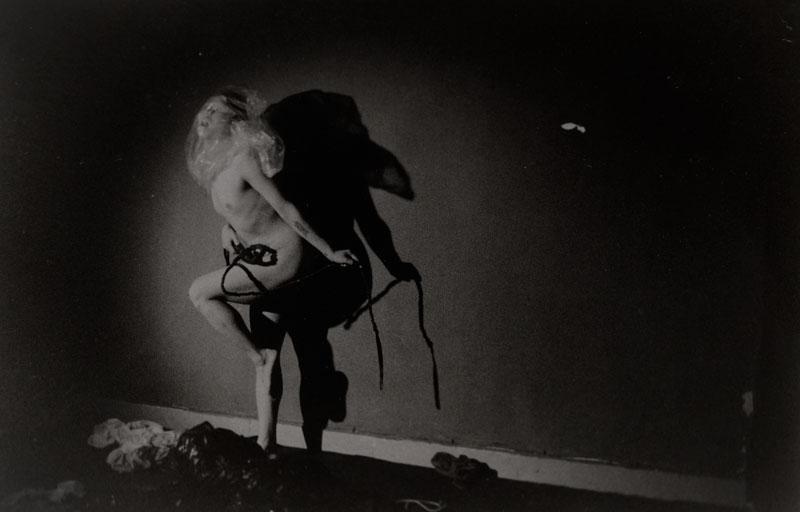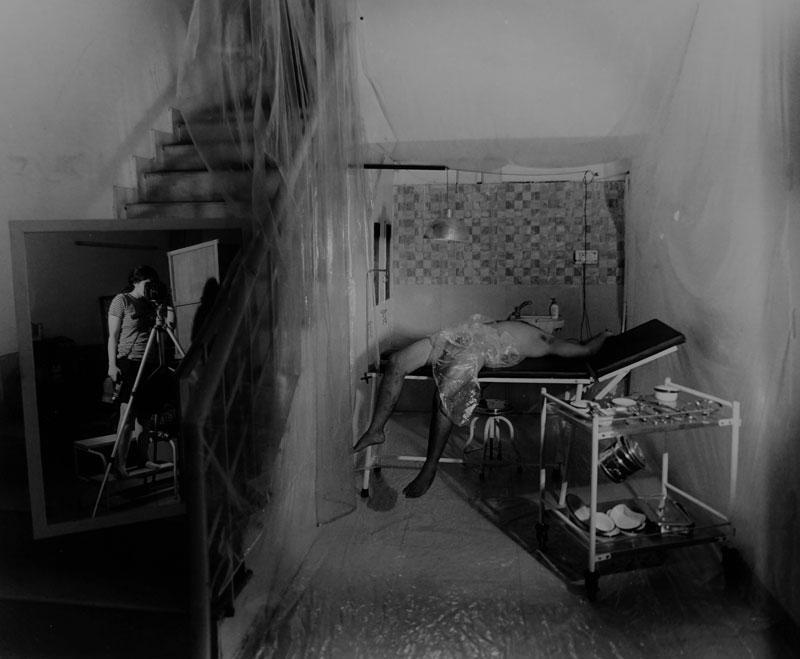Archiving the Corporeal: Zahra Yazdani’s Beautiful and Grotesque Bodies

The Black Room (2022, Silver Gelatin on Fibre-based Paper, 8 × 9.5 inches.)
Zahra Yazdani’s analogue photographs invite us to an orgy of disjointed, fleshy and entangled limbs and torsos. The grainy images startle us into excitement, inciting a prurience as they leave us with a voyeuristic (dis)taste for more. Yazdani’s forms offer a sensorial rawness that relies on embarrassment and vulnerability to explore the political, social and performative desires of the flesh. It is also, however, a fatiguing objectification, an experimental fiction that distorts more than it reveals. Scripted Selves: Sutures of Signs and Symbols, her ongoing solo exhibition at Latitude 28 in New Delhi, is a hypnotic reimagination of the body as overridden with imperceptibility and fiction. Her monochromatic frames manipulate this corporeal performance with subtle yet definitive aggression—the question of exposure convolutes materiality and representation to challenge our ways of seeing (and, more intriguingly, our right to look). There is an uncomfortable bizarreness—a lamina of the grotesque—that rests upon the melding of sinews and tendons in these photographs. One is reminded of Mikhail Bakhtin’s carnival, where obscenity contorts ontologies and sensuous bodies subvert power.

The Pink Elephant (2023, Silver Gelatin on Satin RC Paper, 5 × 7 inches.)

The Pink Elephant (2023, Silver Gelatin on Satin RC Paper, 5 × 7 inches.)
In visualising such theatrical agency, Yazdani’s photographs verbalise unsaid sites of trauma within and around us. An uncompromising testament to this is the series The Surgery Room (2023), where she orchestrates a mutilation of morality and guilt. By manufacturing a crime scene that is replete with hostile and unwelcoming instruments, Yazdani stages a performance of indiscernible bodies that transpose tension onto a militant-yet-unreal landscape. In her remarkably creative execution, transgressive behaviour not only precedes what is deemed “normal”, but is to be desired. This clinical invasion is eerily reminiscent of Mona Hatoum’s Corps Étranger (1994), a claustrophobic endoscopic self-portrait that entails a discomfiting confrontation with irreality. Yazdani’s photographs seek to provide a similar liminal play between surveilled exteriors and trespassed internal lands.

The Surgery Room (2022, Silver Gelatin on Fibre-based paper, 7.5 × 5.5 inches).
Yazdani's images are not “faithful” or “truthful” representations of our reality. The artist’s exposures and manipulations obliviate familiarity. By transcending into what the exhibition identifies as Yazdani’s “staged authenticity”, the contexts of her photographs remain suspended against legitimate realms of occupation. By distorting the space between the personal and the public, these images reside in that third space where we become the viewer as well as the participant, imitating our surroundings as well as fabricating them. Yet, ironically, it is this very deceit that brings Yazdani’s photographs closer to the truth. Susan Sontag in On Photography remarks upon the Kafkaesque relationship we have with photographs today, what she surmises as a “new visual code.” It is the harrowing potential to find ourselves maladjusted to our surroundings, a false sense of power bestowed onto us by a photographed (and therefore, permanently suspended) moment in time that seems within our control. For Sontag, photographs distorted our actual continuous flow of events by breaking them down into collectible instances that are more susceptible to misappropriation and social control. By consciously intervening in the image-making process, Yazdani’s falsifications are able to take back control—or rather, upend it—and articulate a more reliable understanding of perception and cognition.

The Black Room (2022, Silver Gelatin on Fibre-based Paper, 8 × 9.5 inches.)
Despite anchoring Yazdani’s grainy photographs against an expansive curatorial and textual enquiry, the visual language is abstruse, challenging our viewing of her artworks. Dilpreet Bhullar’s essay reflects upon a performative metaphysics that sifts through a string of dichotomies: vulnerability/invincibility, fact/fiction, concealment/visibility, imperceptibility/materiality, public/private, anonymity/confirmation, etc. However nuanced, by situating these photographs in definitive binaries, we fail to reflect upon what attracts us to the artist's work in the first place. It is a corporeal impasse—an aporia—where contradictory meanings inhabit what Jacques Derrida called “…the site at which the text most obviously undermines its own rhetorical structure, dismantles, or deconstructs itself.”
This pivotal blind spot is made glaringly obvious when we try to locate Yazdani’s photographs between the abject/object of desire. As duplicitous manipulations, we are introduced to dysmorphic forms that appeal to an abject reaction, a state of abhorrence that breaks down in the face of what Julia Kristeva called a repressed “corporeal reality”, or between the self and the other. The simulated corpses in The Surgery Room (2023) confront an abjection that epitomises a breakdown between the subject and object. Simultaneously, the images realise themselves as an objet petit a, or what Jacques Lacan called the unattainable object of desire that provides meaning to the symbolic order. To therefore understand Yazdani’s photographs in this Derridean playground where meaning is allowed to persevere as well as remain excluded, it is better to realise their presence as instigators of an irreconcilable conflict than a spectacle that wavers between the banal and idiosyncratic—as her bodies do.

The Surgery Room (2022, Silver Gelatin on Fibre-based Paper, 9.5 × 11.5 inches).
To read more about contemporary art artists working with analogue processes, see Saloni Jaiwal and Hitanshi Chopra on the works of the Kanike collective, Ankan Kazi's essay on Straight 8 (2005) by Ayisha Abraham and an album of works by Arpan Mukherjee, curated by Anisha Baid.
All images are works by Zahra Yazdani, courtesy of the artist and Latitude 28.




